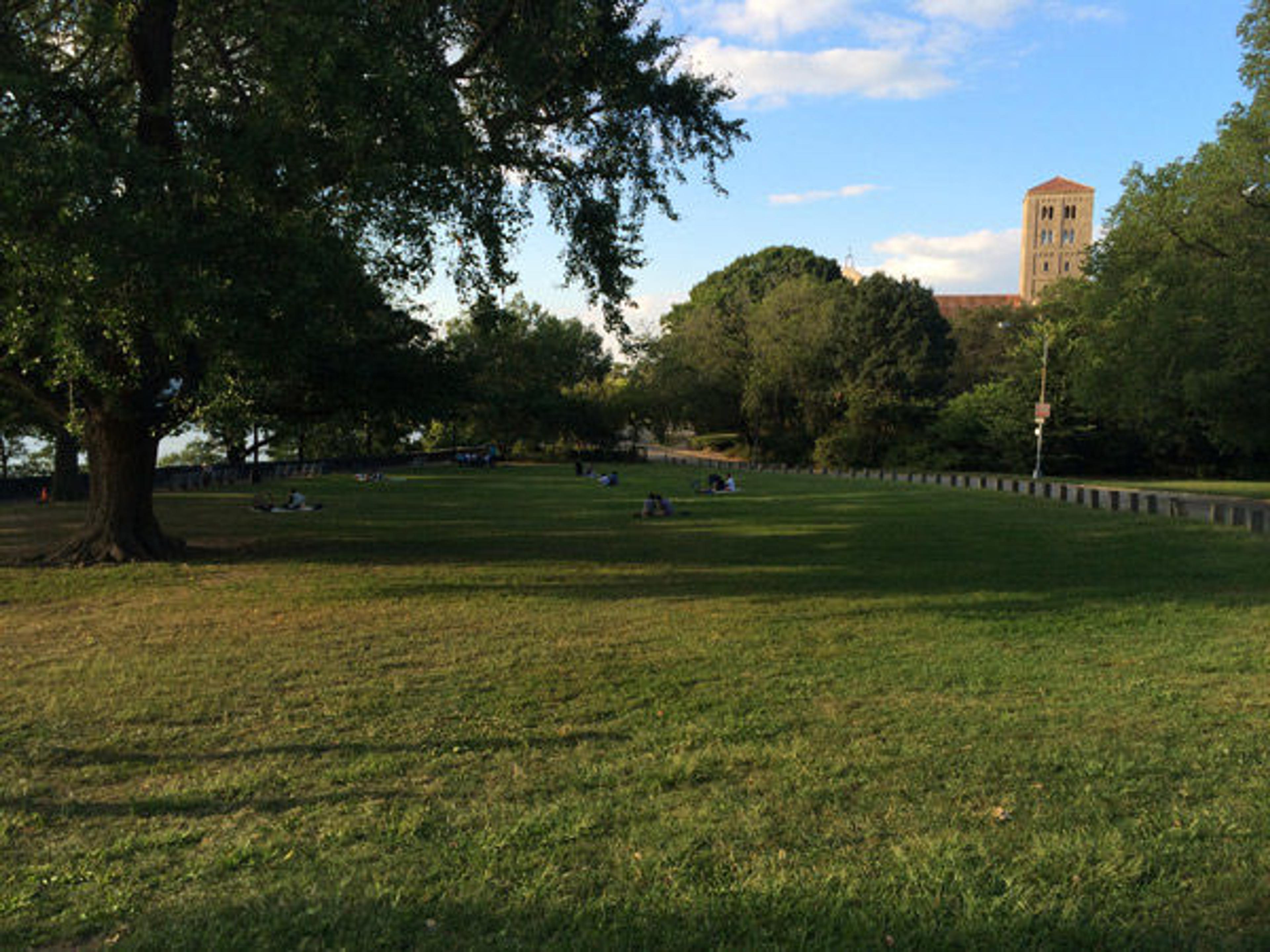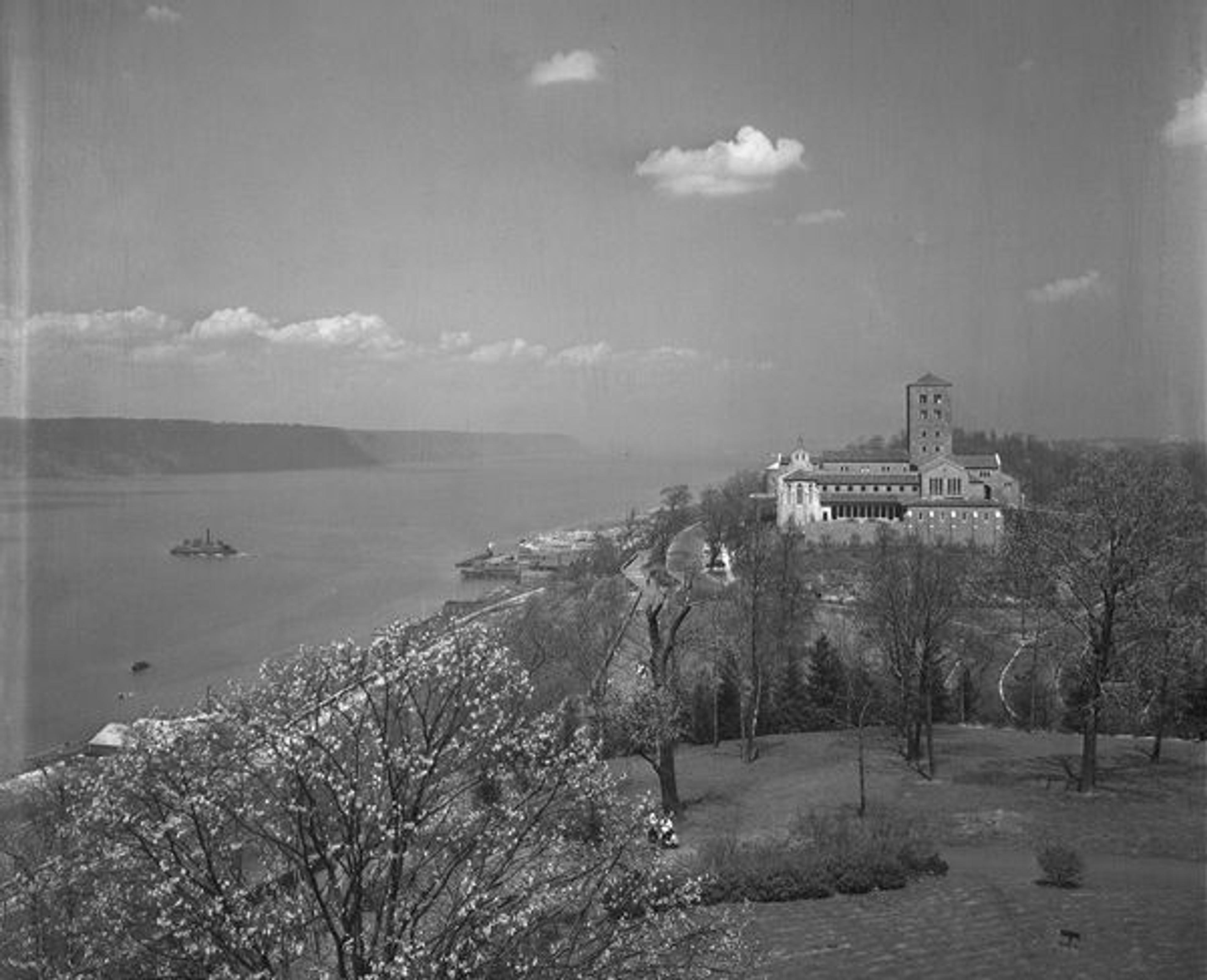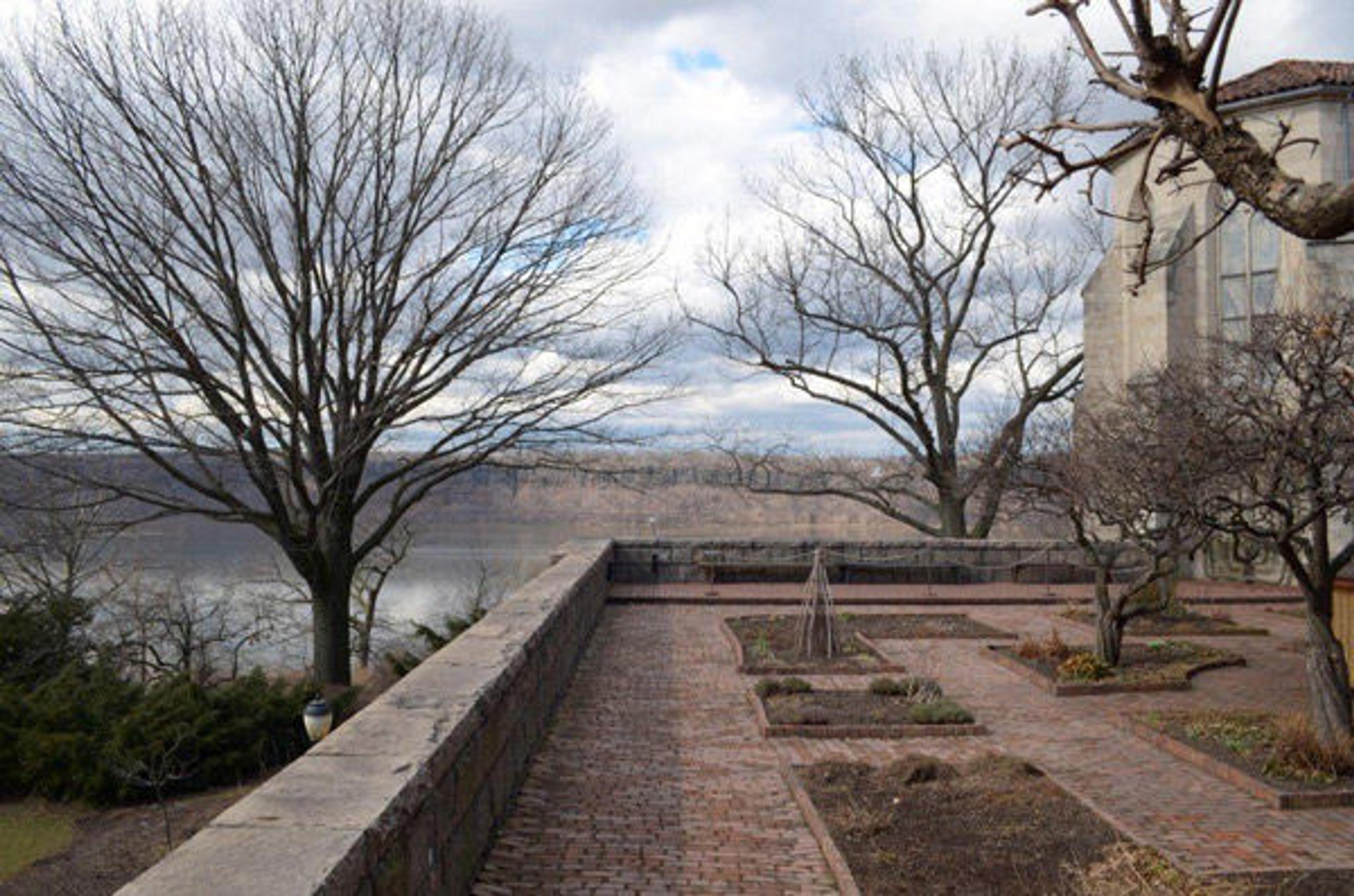
People enjoying a late summer afternoon in Fort Tryon Park with The Cloisters in the background. Photograph by C. Griffith Mann
«On my walks to and from work, I have often noted how people from the neighborhoods surrounding The Cloisters museum and gardens gather in the evenings in Fort Tryon Park to watch the sun as it dips below the Palisades to the west. People jogging, pushing strollers, walking dogs, sitting on benches, or lounging on blankets in the grass are all drawn to the sweeping vistas over the Hudson River. This view, long protected from large-scale development, is now under threat. LG, the Korean electronics company, is in the process of creating a corporate headquarters directly across the river from The Cloisters. In this post, I am not only hoping to build greater awareness of this project but am asking people to get involved in convincing LG to revise its plans, which would alter these majestic views for future generations. While this is an issue that we care deeply about at the museum, it also has broader implications for all who come to this corner of Manhattan seeking temporary relief from the hustle and bustle of urban life.»
From its beginnings, The Cloisters was intimately connected with the lands around it. The rocky, wild site of the museum, emulating the remote setting of a medieval monastery, dramatically accentuated the sense of being transported in time and place. At the public opening of The Cloisters on May 10, 1938, one of the key celebrants was John D. Rockefeller, Jr. His vision and philanthropy had not only brought the museum into being, but had created the surrounding Fort Tryon Park. Whether from the ramparts of the newly completed building or from the long walkways along the park's western slopes, the project took full advantage of the unparalleled views up and down the Hudson River and west toward the Palisades.

Photograph taken looking north toward The Cloisters, April 13, 1938, a month before it opened
One of the more prescient speakers at the event was Robert Moses, commissioner of parks of the City of New York. The Palisades, as even Moses recognized, were a critical element in the successful realization of the whole endeavor. Moses stated:
There is one thing about this city that the Mayor [Fiorello La Guardia] did not mention here today, but which he did refer to recently when we opened the upper level of the Henry Hudson Bridge, and that is the protection of the background, the back-drop… on the New Jersey side. And that brings me to a reference to the Trustees of the Metropolitan, who in past years have done so much to preserve the Palisades, beginning with Mr. Morgan and others. If we had not that private interest at that time, I am sure that the other side of the Hudson would today be surmounted by apartment houses and buildings of all kinds; the shore front would have been ruined; we should have an ugly, obtrusive skyline; and we would not have the uninterrupted and unspoiled view and the protection that we have now. To climax this program, Mr. Rockefeller began at the George Washington Bridge and acquired all of the strategic pieces of property along the top of the Palisades to the line between New York and New Jersey, so that for all time that area will be protected. The Parkway and the buildings will be set back far enough, so that we will always have the view that we have today. (Addresses on the Occasion of the Opening of the The Cloisters in Fort Tryon Park, 21)
To understand the context of this statement, it is necessary to look back to the origins of the efforts to protect the Palisades from development and to secure the rugged beauty of the views across the river. These date back to the first decade of the twentieth century. In 1900, the governors of New York and New Jersey formed an Interstate Park Commission to protect the Palisades from aggressive quarrying driven by the incessant demand for building material in a rapidly expanding city. J. P. Morgan, the banker and philanthropist, routinely passed beneath the towering bluffs of the Palisades on his trips up the Hudson to Cragston, his estate near Highland Falls. Traveling by water, Morgan was no doubt keenly aware of the natural beauty of the remarkable geology of this area, and also a witness to the quarrying that threatened to denude the landscape. When approached about protecting the cliffs from further quarrying, J. P. Morgan agreed to fund the purchase of twelve miles of shoreline and the vertical rise from the river to the heights. Together with the Interstate Park Commission, this purchase was the first significant step in securing and protecting the Palisades for future generations.
By the time The Cloisters and its surrounding Fort Tryon Park were in the planning stages, John D. Rockefeller, Jr. had entered the final phase of a scheme that had been decades in the making, and that would forever transform the rocky escarpments on either side of Hudson River. On the east side of the river, in Washington Heights, Rockefeller had acquired the last parcels of privately held land by 1926. His long-held vision of creating a public park, later to be dedicated to the city as Fort Tryon Park, was close to realization. Beginning in the early 1900s, Rockefeller also purchased land from the edge of the plateau on the west side of the river. With the completion of the George Washington Bridge and the arrival of the age of the automobile, the Interstate Parks Commission created the Palisades Interstate Parkway. Again, Rockefeller's philanthropy was instrumental. In 1933, Rockefeller gifted some seven hundred acres of land to help realize the parkway.

The Palisades from Bonnefont Garden at The Cloisters, 2013. Photograph by Andrew Winslow
Now, seventy-five years after the dedication of The Cloisters and Fort Tryon Park, the Palisades are in danger, as is the vision that brought the museum and the park into being. The World Monuments Fund has declared The Cloisters and the Palisades a Watch Site in response to LG's project, and has joined a coalition of advocacy groups led by the Natural Resources Defense Council to raise awareness of the threat to this unique site. We hope that you will appreciate how important it is to convince LG to alter their plans, a change that is possible without threatening jobs or the tax base in Englewood Cliffs, which created a zoning variance to allow the building in its currently proposed vertical design. Making a change in the building plan at this stage in the process is certainly not without financial consequences for LG. However, the company also has much to gain by building lower, as do the communities surrounding the corporate park. Michael Kimmelman of the New York Times and others have argued that views are hard to protect, especially when there are conflicting interests and multiple jurisdictions involved (see "Corporate Design: An Energizer Versus an Eyesore" [April 9, 2014]). At the same time, where one company and township opens the door, others are sure to follow. For three quarters of a century, development along the Palisades has advanced within the constraints imposed by zoning. LG and Englewood Cliffs can still find a solution that preserves what others before them have worked to protect for future generations.
Please get involved. We recommend starting with Protect the Palisades, one of the many advocacy groups that have organized around this important issue. What we hope to preserve for the future resonates powerfully with the vision John D. Rockefeller, Jr. himself articulated when The Cloisters first opened:
If what has been created here helps to interpret beauty as one of the great spiritual and inspirational forces of life, having the power to transform drab duty into radiant living; if those who come under the influence of this place go out to face life with new courage and restored faith because of the peace, the calm, the loveliness they have found here; if the many who thirst for beauty are refreshed and gladdened as they drink deeply from this well of beauty, those who have builded here will not have built in vain. (Addresses on the Occasion of the Opening of the The Cloisters in Fort Tryon Park, 26–27)
Source
Addresses on the Occasion of the Opening of the The Cloisters in Fort Tryon Park. The Gift of John D. Rockefeller, Jr. May Tenth, 1938. New York: The Metropolitan Museum of Art, 1938.
Related Link
Husband, Timothy B. "Creating The Cloisters": The Metropolitan Museum of Art Bulletin, v. 70, no. 4. New York: Metropolitan Museum of Art, 2013.